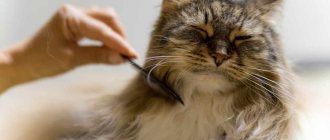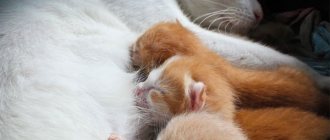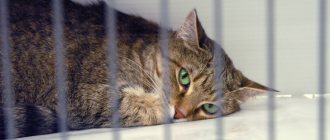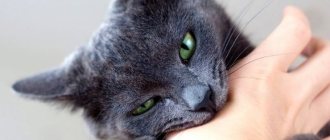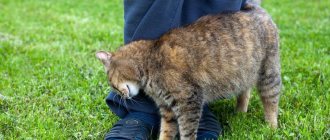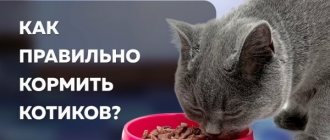Home » Useful Information
Cats are famous for their cleanliness; they carefully groom themselves, regularly licking their fur. This procedure is not only part of hygiene, but also an element of self-soothing, so it is not at all surprising that pets can spend a lot of time doing this activity. But licking also has an unpleasant side - the fur enters the digestive tract, where it accumulates and is periodically released through vomiting. A caring owner has the opportunity to help his pet effectively get rid of swallowed lumps.
- 2 Basic rules for preventing hair accumulation
- 3 Food for hair removal
3.1 Review of food for hair removal
3.1.1 Table: comparison of dry cat food with hair removal effect
- 3.1.2 Photo gallery: preventative food for cats with hair removal effect
Seasonal molt
Oddly enough, most calls to veterinary clinics regarding excessive hair loss in cats occur in the winter. The four-legged animals that came to the doctor look healthy, active and have a good appetite. As for fur, apart from its profuse hair loss, no alarming symptoms are observed.
The reaction of the owners is understandable, because by winter the animal should acquire a luxurious fur coat, and an almost hairless cat without undercoat looks suspicious. However, there is nothing critical in such a situation; a cat can shed in winter.
There are several reasons:
- Natural molting (autumn) can last for 2–3 months.
- A cat may begin to shed if the temperature in the home exceeds 22–25°.
- When heating radiators are running, the air in the house becomes dry, which can lead to prolongation or resumption of shedding.
Note! If the cause of hair loss is shedding, the guard hair should remain healthy, shiny and elastic.
Normally, seasonal molting occurs twice a year (spring and autumn) and lasts up to 3 weeks. In spring, the cat sheds its undercoat and renews its guard hair. By winter, the animal again grows undercoat. It should be noted that cats shed more than cats, and if the home is warm, they can shed all their fur except for the guard (long) hair.
Important! If your cat's shedding is prolonged, she should take a vitamin course to maintain the level of nutrients and trace elements.
Dry food for hair removal
Cats are very clean. Every time they lick themselves, the hairs cling to the tongue and enter the gastrointestinal tract. There, the wool can accumulate in clumps for a long time, clogging the animal’s stomach. This poses a particular danger during seasonal molting. The stomach is not able to digest this wool on its own, and the animal does not have access to grass, thanks to which this problem can be solved in the wild.
There is only one way to remove lumps from the stomach, but regurgitation causes a lot of inconvenience, causing discomfort to both the owner and the cat itself. If, for some reason, they are not eliminated from the body at all, over time the animal will need serious surgery. Symptoms of hair accumulation in the body are:
- vomiting in an animal, with traces of hairs;
- strange changes in behavior, decreased activity;
- dry cough;
- changes in appearance: the coat becomes dull and quickly becomes oily.
In order to prevent this stage and further complications, it is better to immediately take care of purchasing specialized hair removal food immediately after detecting these symptoms.
How the feed works
The composition of the food in this line includes additional plant components and fiber. They contain high-quality protein, which allows them to be used as a complete feed, and fiber, which softens hairballs. And the fatty acids contained in this diet in large quantities envelop the stomach, making the movement of lumps through the gastrointestinal tract simple and painless. Thanks to such food, removing hair from the stomach will not cause any discomfort to the animal.
Feed examples
Almost every food manufacturer is trying to add a type to their line that will make hair removal easier. The most famous and effective foods are:
- Royal Canin Hair and Skin is a premium food with a good composition, which includes many vitamins and fatty acids. Owners in their reviews note a positive effect: the fur becomes beautiful, fluffy, and the unpleasant smell of feces disappears.
- Pro Plan Elegant Opti Derma is a balanced food with salmon containing all the substances necessary for the coat.
- Nutra Mix Hairball is a special medicated food for removing hairballs. It features a completely balanced composition of substances and a low price.
- Monge Cat Hairball is a premium chicken food that contains a small percentage of fiber and vegetable protein. Enriched with calcium, magnesium, vitamins. Excellent for removing fur from the body.
It is worth remembering that the animal may have allergies or individual intolerance to such food. This is not a reason to be disappointed; there are many different foods from different manufacturers that will help you easily cope with the problem of fur and its care.
For a better choice of therapeutic food, it is better to contact a veterinary clinic.
Features of feeding
Not all of these foods contain enough ingredients to be used on a regular basis. Feeding should be started immediately after symptoms appear, and stopped after the problem disappears. The average duration of such treatment is 1 month. After this, you can give it 1-2 times a month for preventive purposes.
Since this food is fattier and more nutritious than regular food, feeding rates will be reduced. On average, 15-20 g of special food is needed per 1 kg of animal weight.
Skin diseases
The second most common cause of hair loss in cats is skin diseases or acute reactions . In this case, the wool will not look shiny and elastic. Often there are split ends of the hair, creases or bald areas.
A relatively safe, but worth considering reason is an allergic reaction. Cats with this disease often experience itching of large areas of the skin as one of the symptoms of an allergy. Veterinarians note that a cat can literally comb its fur, that is, the hairs will break from scratching and the animal will go bald. However, upon detailed examination, you can find that the skin is not completely smooth, but is covered with stumps of broken hairs.
Stress.
Some cats shed more when they are nervous, scared, or stressed. Solution: Check your cat for other signs of stress, such as hiding, trembling, or trouble urinating. Remember what changes have recently occurred in your home (the appearance of a new pet, loud noises, etc.) and try to change the environment so that it is less annoying to the animal. Make sure your cat has a couple of places where she can hide and feel safe.
Parasites
Allergy is an unpleasant disease, but it can be controlled, and attacks of itching are eliminated with medication. More serious harm is caused by parasites that live on the skin and in its layers.
Quite often cats go bald due to:
- Flea dermatitis - the cat is infected with fleas and has an intolerance to the components of the parasites' saliva. Flea bites itch, the situation is further aggravated by an allergic rash, which significantly increases the itching. The problem is that flea dermatitis can develop even if there are 1-2 fleas on the cat, that is, at the earliest stage of infection.
- The subcutaneous mite is one of the varieties of microscopic mites that lives not on the skin, but on its upper layers. Parasites gnaw tunnels in the skin and constantly move through them. The condition is accompanied by severe itching and loss of six.
- Ear mites – when infected with this parasite, a cat quickly scratches its head, face and ears. Bald patches quickly turn red and become infected.
- The scabies mite is a parasite that spreads quickly and can live on any warm-blooded animal (and humans). Due to severe itching, the cat scratches the skin, which quickly becomes inflamed. Infected animals quickly lose hair and develop severe scratching.
- The lice beetle is another parasite that infests the hair follicles. The lice eater feeds on the skin, blood and directly on the fur of the animal. It is impossible to detect the parasite visually; for diagnosis you need to take a skin scraping.
To prevent parasites, your cat should receive regular preventative care. The pet must be treated even if it does not go outside, since ticks and fleas can be brought into the house on clothes or shoes. If the cat is already infected, treatment and prevention of the spread of parasites is required. When infected with subcutaneous and other types of ticks, the animal's bedding and personal belongings must be carefully processed or burned.
Rating
It is worth paying attention to the most popular products from well-known manufacturers.
- Royal Canin Indoor Long Hair. This food is preferred by everyone who cares for their pet. It contains plantain seeds, and also helps remove hair from the stomach and improve the gastrointestinal tract. Borage oil is an element included in the product. It helps maintain the tone of the circulatory system, so that the hair follicles receive nutrients. The cat's fur looks great no matter how old she is.
- Fitmin Cat For Life Hairball. This food is suitable for adult cats with long hair, but it should not be fed to kittens. The product contains pork liver, poultry, eggs, animal fat, bran, flaxseed and so on. The products of the Czech brand are safe to feed your pets, since the food does not contain GMO products. After eating the food, your cat's fur will become healthy and soft.
- Schesir Hairball is a line of dry food for dogs and cats. It will be appreciated by those with long hair - Persian cats, Maine Coons, and so on. There are no preservatives or dyes in these foods, but the product is based on 100% natural ingredients - meat and fish that humans eat.
- Royal Canin Hair & Skin is a professional, balanced food. The effect can be noticed after a month - the cat’s fur becomes smooth and beautiful. Cats eat this food with pleasure, and their coat noticeably improves. Dry food contains Omega-3 and Omega-6 fatty acids. They are needed to maintain the protective function of the skin. High-quality food for your beloved pet will make the cat healthier and give its coat shine.
When choosing food for your beloved cat, do not forget to take into account all the nuances: age, coat condition and health of the animal. If you are in doubt about the choice of product, it is better to consult your veterinarian. When choosing food yourself, always read reviews and be careful, because we are talking about the health of your furry friend.
To see what food your veterinarian recommends for your cat, watch the following video.
Fungi
Fungal infections, better known as lichen, are characterized by hair loss in certain areas of the skin. If the animal does not receive treatment, the affected areas of skin enlarge and merge together.
Depending on the type of fungus, receding hairline patches may appear clear, scaled, scabbed, or scratched. The first signs of lichen are often overlooked, so for the purpose of prevention, the cat must be completely examined once every 2-3 days. A small, round patch of hairless hair is an almost guaranteed sign of the most common ringworm. Please note that ringworm (and others) is quickly transmitted to people and other animals.
The best cat foods in the category: holistic
There can be nothing better for your beloved pet than dry food from the Holistic series. These are new generation products that are created by professionals for professionals. The composition of this food is as natural as possible, it contains no preservatives and is as digestible as possible for the animal. In the line of companies producing holistic food, there is an offer for every taste, but not for every budget - such products are very expensive, because they require not only high-quality raw materials, but also special production technology.
Unbalanced diet
A conclusion about hair loss due to an unbalanced diet can only be made if there are no alarming symptoms. If the hair falls out symmetrically, there are damages on the skin, the hairs stick together and break – these are not food problems.
It is very difficult to differentiate all possible problems, so it is better to consult a doctor.
The cat should be examined for:
- Diseases of the endocrine and hormonal system.
- Food and non-food allergies.
- Diseases of the blood and immune system.
- Disturbances in the digestive system, dysbiosis, intestinal inflammation.
- Other systemic diseases.
Hair loss in a healthy cat indicates vitamin deficiency or a lack of microelements. As you understand, this happens when the diet is unbalanced or not properly fortified. For example, not all premium foods contain a full range of vitamin supplements, but they are recommended for everyday feeding. With constant feeding of economy class food, the development of vitamin deficiency is guaranteed.
With a natural diet, vitamin deficiency can develop for two reasons:
- An unbalanced diet - not enough meat, offal, vegetables, fats.
- Including harmful or controversial foods in the diet. For example, with frequent consumption of fish, a cat may develop vitamin deficiency, since the product contains acid, which removes vitamins from the body.
Feeding your cat food with spices, marinades and salt can lead to hair loss. Sausage products very quickly disrupt fat metabolism and lead to deterioration of skin condition. As a result, hair growth slows down and the owner thinks that the cat is going bald.
Food for cat hair
There are special foods that will improve the condition of your animal's coat. They contain special vitamins and essential fatty acids. Many problems with an animal’s fur coat can be solved by purchasing such special food. And thanks to them you can get beautiful and shiny wool.
Food for cat hair can be divided into three types:
- to remove hair from the stomach;
- to improve the appearance of the coat;
- against hair loss.
Some premium and super-premium foods combine several actions. This makes it easy to solve all hair problems simply by choosing one such food.
How to balance your diet?
You won't invent anything new. If your cat eats commercial food, consider switching to a product from a different manufacturer or a higher grade. When keeping a natural diet, the cat must be fed correctly.
The diet is based on meat and offal. Please note that the cat should consume up to 80% protein food per day , that is, meat, dairy or fermented milk products. If the cat has no problems with weight gain, it is better to exclude porridge from the diet. Fish should be considered as a delicacy, that is, little by little, rarely, and only noble varieties. In addition to proteins and fats, the cat needs hard fibers, and these are vegetables and herbs. Naturally, vegetables need to be chopped and mixed with meat or dairy products. Cats most often eat greens and grass themselves.
Note! If you are on a natural diet, be sure to take vitamin courses at least 2 times a year.
Health problems.
There are several types of health problems that can cause heavy shedding in cats. The American Society for the Prevention of Cruelty to Animals includes allergies and parasites. And, conversely, shedding can begin from medications: taking some medications can cause itching or flaking, causing the cat to start scratching itself, and this already leads to excessive shedding. During some illnesses, animals lick themselves too hard. This causes them to develop bald spots. Solution: Take your cat to the veterinarian. If she sheds heavily, you need to make an appointment with a veterinarian to rule out possible diseases. If your cat is already prescribed medications, ask your doctor if they have any side effects such as excessive shedding.
